
Introduction :
The COVID-19 crisis is spreading at an extraordinary speed. You have created a crisis team in your organization and you are doing your best to keep your people safe, to get back to your previous level of work and face various uncertainties in the constantly changing situation. . With these interpretations, it is likely that there will not be enough good decisions.
Being in the crisis of the spread of the corona virus is the next wave of disruption that is coming our way. And this wave is not just an economic shock, it is a shock to customer behaviors and business models. The challenges associated with this condition are greater than what we are usually used to. To address these challenges, you must adopt an operating model that incorporates an extreme level of uncertainty into your business.
Most companies will be vulnerable to the economic collapse that occurs due to employees being quarantined. Since your business is going to face many other issues, there are two practical steps you can take to move these issues forward:
- Setting up a PLAN-AHEAD team to advance the next phase of the crisis.
- Guide the team to work across multiple time horizons, using five frames
The leading program team helps to elevate your vision above the day-to-day response of your crisis management team. The PLAN-AHEAD team helps to improve your view of the daily reports of your business crisis management team. It aims to enable the single, scalable thinking that every CEO needs to navigate this unprecedented and rapidly evolving situation. The PLAN-AHEAD team provides a strategic operational crisis plan to guide and accelerate your decision making.
Formation of the PLAN-AHEAD team
Military organizations, which specialize in dealing with macro-crises, often create granular structures (management structures with multiple small components) to respond to very specific tasks such as operations, communications, and intelligence gathering. However, they all use program development teams for key decision makers to leverage when dealing with complex and escalating problem sets.
Your program development team should gather prospective information, develop scenarios, and identify options and actions required for tactical and strategic action. Unlike a typical strategy team, it must plan across all time horizons (two, four, and seven days; two and four weeks; three and six months; one year and two years; and other common time horizons) so that you can Make the right decisions in the most important and critical situations, and in this time of uncertainty.
A program advancement team provides scenarios and recommendations for actions and provides highlights to the CEO and management team so they can decide on the right course of action. These decisions are communicated to the crisis team or other parts of the organization for implementation. If it is necessary to further explain and clarify the scenarios, the program development team collects more information to reduce uncertainty.
Importantly, the structure of the program development team is modular (consisting of small units), which includes individual cells that focus on specific issues in the desired time horizon. As new topics emerge or the time horizon expands, you may need to add new cells. This causes the team to change its scale according to the severity of the crisis.
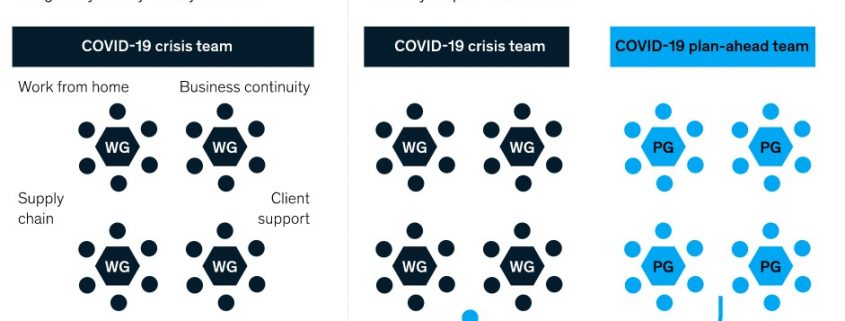
While the members of these teams may be the same regular employees of the strategic planning unit, it should be noted that the duties and responsibilities are very different from what they do. In today’s environment, forward planning requires a dedicated effort, with a full-time senior manager and a team of high-potential employees, who must be in constant and easy communication with the CEO.
As a first step, the team needs to develop a one-day version of a crisis action plan using the five specified frames outlined in the next section of this article. Speed is of the essence, and waiting for complete responses can be counterproductive. You have to deal with uncertainty, not let it cloud your decision making. Your planning team must constantly update and improve plans by integrating new information.
Five frames in multiple time horizons
The best response to navigating the COVID19 crisis and achieving recovery will vary based on each company’s circumstances. According to some, the optimal approach would be to relax and continue working. Others may need to fundamentally restructure their cost bases and business models.
Even as you evaluate the best path forward, you should never do what you routinely do for strategic planning. Review all the uncertainty scenarios or relate similar uncertainty conditions to the risk analysis you have already done in the organization. As soon as the events caused by the crisis are revealed, you can use your strategic crisis action plan for the next steps of the crisis.
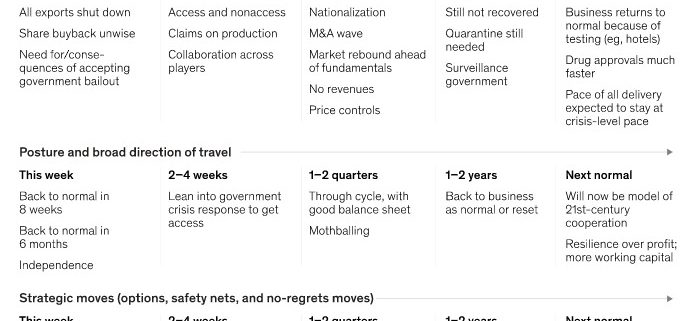
To prepare this plan, you must consider the consequences of uncertainty. Your program development team should work within the framework of the following five frameworks:
1. Get a realistic view of your starting position.
2. Develop scenarios for the future that is going to happen for you.
3. Determine the condition and extent of the path ahead of you.
4. Determine the strategic actions and movements that are constant in all scenarios.
5. Adjust the heel points (critical) of the path that will lead your organization to work at the right time.
It is not enough to emphasize that speed is a principle. Your planning team needs to move fast, provide you with tomorrow’s analytics every day, and iterate at high speed. If new issues or opportunities arise, add units to your planning team. So do not slow down in any case. The next few weeks and months will shape your company and possibly your industry. After proper planning, the passage of time in the next few weeks or months will shape your business.
-
Get a realistic view of your starting position
In times of extreme uncertainty, you should start with a clear baseline of your company’s last known position. You don’t have time to practice. Your existing strategy can be an anchor (inhibitor) in regularly evaluating what has changed.
Your planning team should define its position in three main areas: Financial assumptions, ongoing initiatives and major strategic choices. Referring to a three-year plan and listing the planned assumptions in that document, helps to determine the factors affecting the company’s financial performance.
These factors should be classified into three levels: The ones that still sound right, the ones that are wrong, and the ones you’re not sure about. If possible, perform a sensitivity analysis to assess which assumptions are most significant.
The next task is to list the big initiatives in progress, starting with the projects that are high on your spending list and dividing them into similar categories as in the previous paragraph.
The last step is the list of big strategic options that underpin your company’s business model, for example, maintaining the premium price, investing in a physical network, etc., also sort them into three levels. Now you have lit the starting image and brought the important subjects to the foreground.
-
Develop scenarios for the future that is going to happen for you
The traditional approach of strategic planning is paralyzed in such circumstances, now more than ever, you cannot escape uncertainty. You have to deal with it. A good way to do this is to create scenarios, of which Mackenzie’s Global COVID-19 Scenarios is a useful starting point.
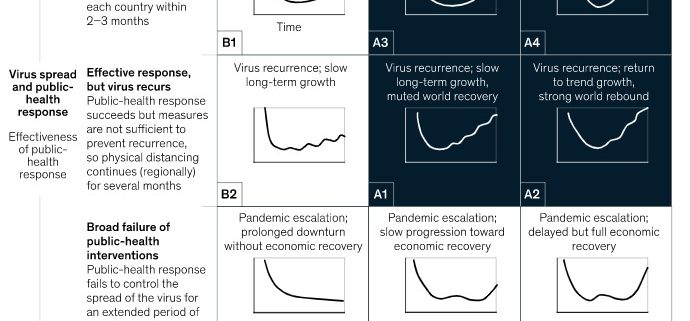
We included two uncertainties associated with the crisis – the spread of the virus (and the associated health response) and the effects of economic shocks (along with public policy responsiveness) – and examined them in macroeconomic outcomes.
The point is not to argue which scenarios are more likely, but rather to explore what is possible and prepare for whatever seems plausible. Leaving out the most extreme events (leaving out pessimistic scenarios) is exactly where any scenario analysis often fails. While some situations may seem too terrifying for the public to think about, that doesn’t mean they should be ignored. Your planning team should create at least four scenarios. If you only have three, by default the main option is the intermediate option that will be selected.
Next, your planning team should test your company’s performance and strategy against each scenario by translating the scenarios into business model outcomes. Determine what risks your business is most at risk of. And where is the most resistance? Estimate your capital shortfall in the worst case scenario. Then evaluate your current slate of strategic initiatives against each scenario, determining whether each initiative should proceed as planned, be accelerated, or halted.
Creating scenarios has immediate benefits. It allows you to narrow uncertainty into manageable and measurable categories, reduce confusion, and sort out what is truly unknown and truly important. You can confidently identify regret-free moves to address a wide range of possible outcomes. Finally, it allows you to identify signals that are early indicators of a scenario taking place and act accordingly.
It is critical that a program development team takes multiple scenarios as input and turns them into concrete ideas for action. However, it is also important that the team has a set of planning assumptions to provide as input to other teams in the organization. If the planning team believes that the company should default by 8% GDP, then the portfolio building team cannot consider any other hypothesis.
One approach that we find useful is to create a clear picture of the threats and opportunities we may face. Then think about how the evolution of that threat or opportunity could affect your business performance. Running this loop a few times will help you gain a nuanced view of how the business environment is changing.
A planning team is best positioned to define the inputs that are necessary for the organization’s scenario development and decision making. Because this team is responsible for collecting relevant and high quality information for the organization. The reason is simple: Gathering quality information about the business environment and the economy is a costly endeavor that usually requires nuance and analysis.
-
Determine the condition and extent of the path ahead of you.
One of the most important responsibilities of the program development team is to determine the best response to the evolving situation based on the company’s post-crisis situation. While some companies may need to enter a long and difficult period of slow restructuring, others will find opportunities, strategies and innovations in the short term. The goal is not to make detailed plans, but to understand what the scope of our journey is – identify the big idea theme that you can develop a strategic response to. In a world full of uncertainty, you need to pursue a goal that is more important than other goals. This big idea brings coherence and determination to your tactical response.
During the COVID19 crisis, a perspective on things that are going to change forever is essential. This will help you avoid future fence approaches where you spread your resources like peanut butter across many opportunities without really defining a clear position on these opportunities for your organization. Many successful companies have faced these moments when they have had to prepare a vision for the future. For example, in the 1980s Bill Gates didn’t know that his operating system would dominate others, but he knew that, in all scenarios, personal computers would be the next big thing, and that computers would run on graphical user interfaces. He also knew that there was a possibility that he would win this route and take all the market. This led to Microsoft taking advantage of the status quo in its bid to win the PC operating system.
As you develop scenarios, you will think about how to explain the dual shocks to demand and your business model. You may see several possible versions of the “next normal”. Now that you see the doors of possibilities open to you, it can help you to consider the direction and extent of your journey.
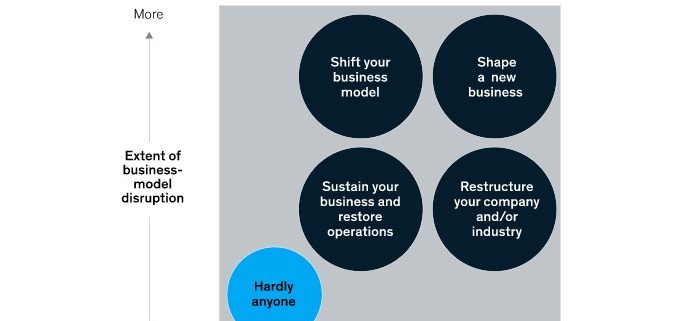
With the COVID19 crisis, hardly anyone is in the bottom corner of the map shown in (Figure 4), because the challenge is so pandemic. Some jobs will be a necessity for sustainability (for example: essential shared services, such as consumer telephone and retail electricity), as their return to normal will be accompanied by different recovery speeds. Others primarily to restructure with a shallow demand environment (eg airlines and cruise ships) must restructure themselves. Other companies have less demand shock but will face different customer behavior. They need to change their business models. However, other companies and industries find themselves in a completely different area on both axes shown in (Table 4) and they have to form completely new businesses.
One of the remarkable features of the COVID19 crisis is the fundamental change in the distance between business models. Within a few days, people have achieved widespread use of technologies that enable remote learning, work, service and consumption. Will this adaptability stop after the crisis or will we go to a new situation? As a result, should you accelerate your investments in a digital business model now? Should we scale back our investment plans to increase our physical footprint in favor of secure bandwidth to host our virtual businesses? Due to the level of uncertainty, you cannot put all your eggs in one basket or bet. An important result of this frame is to create a belief in future issues before defining any initiative.
4- Determine the strategic actions and movements that are constant in all scenarios.
In a world of extreme uncertainty, a strict and definite plan is not correct for a long time. On the other hand, flexibility against everything can be an expensive road to nowhere. Instead, you should think about creating a portfolio of strategic moves that will perform reasonably well in all possible scenarios, even if not every move is a winner by itself.
A tried and tested method is to make the optimal set of moves by implementing a scenario that you know can be eliminated. Start with your existing list of initiatives—the ones that were on file with the organization before the crisis—then look for broad opportunities and threats against that list. Then explore the commonalities and major differences between scenario-specific strategies and initiatives.
Some initiatives will make sense in all scenarios. These are moves you won’t regret and you can move forward with confidence. Others pay a lot in some scenarios but may hurt in others. These are big bets, and the key here is to gather as much information as possible before making a decision. If possible, you should try to divide them into smaller parts, invest in different phases of the field to reduce the risk of a large, one-sided investment under high uncertainty.
Other moves are about taking action on preferred options. When volatility is high, options with higher in-the-money values are more valuable, so now is a good time to option these options. For example, oil and gas exploration companies and film studios do this as part of everyday business, when you are looking for such options, they can be everywhere in your work. Finally, there are moves you can consider that will further protect you from the downside. You can’t avoid risk, but these safety nets can help you take less risk and make the downside less steep.
The result of this framework should be a portfolio containing several strategic moves (typically 12 strategies), ranging from no-regret moves to no-return moves that can irreversibly change the future of a company. give Ensure that movements related to each issue are fully synchronized with key decision makers and stakeholders, both inside and outside the organization. Ideally, you should do this through workshop exercises that force decision makers to consider the likelihood of the actual outcome of actions in moves that may seem unlikely at the moment.
5- Set the heel (critical) points of the path that will lead your organization to work at the right time.
In an environment as uncertain as the environment of the COVID19 crisis, the passage of time makes a rigid plan obsolete. The world is evolving rapidly. You still don’t know which scenario we are approaching. But you should try to be the best learner (be the first to know where the world is going) and the best adapter (the one who makes the best decisions and iterates the program). Achieving such conditions does not depend on starting with a complete plan: Accessing these conditions is about being on the fastest track to progress. In such a fast-paced world, even a great program will become obsolete.
As discussed, most of the moves we describe are reasonable only under certain conditions. However, many companies facing disruption only act when conditions are clearly deteriorating. These conditions are accompanied by emotional and potentially consensus-based decisions, delays or non-implementation that occur in many management teams.
To avoid such an issue, it is very important to ensure that each move is well articulated with a set of specific points for action at the appropriate time so that the organization can begin planning and executing the move in detail. Those decision points for taking action are when the probability of that necessary move increases and it is reasonable to invest in a team to ensure that the organization can act quickly in these circumstances. Deciding when the milestones are reached – and when detailed planning and execution should begin – is the CEO’s primary role in relation to the program development team.
Master it in a race against time
In times like these, being on the fastest track is more important than having a great app because apps become outdated quickly. Staying in the race against time means doing the following moves:
Turn your actions and portfolio of moves into a practical crisis strategic plan, and turn them into options on your table, “early decision making.”
Bring all the initiatives in this plan closer to your short-term goals and decision points. This gives you visibility and allows you to direct action at the right time.
Create a set of indicators that are gathered in a control unit to act as an early warning system so that the desired signal can be seen. Your job is not to recognize unfamiliar situations, but you should be the first one to understand the situation and take the fastest action. This requires a supervisor who can see the signals first, along with a plan that is flexible and ready to act at the desired points.
In addition, the reality of many companies we talk to is that their current budgets are in disrepair and they have no reliable way to determine new budgets. This team formation gives an agile and lean approach to the organization so that resources are allocated at the right time. The budget will be implemented and released step by step. And it forces you to quickly close the long-standing gap between strategy and financial performance.
You will feel such decisions many times in such situations, and you most likely do not have the time and ability to manage them alone. For this reason, even when your crisis team is busy keeping existing businesses in your organization, you need to have your modular and scalable planning team by your side to support your iterative planning cycle during the crisis. – And this is done regardless of the complexity of the problem.
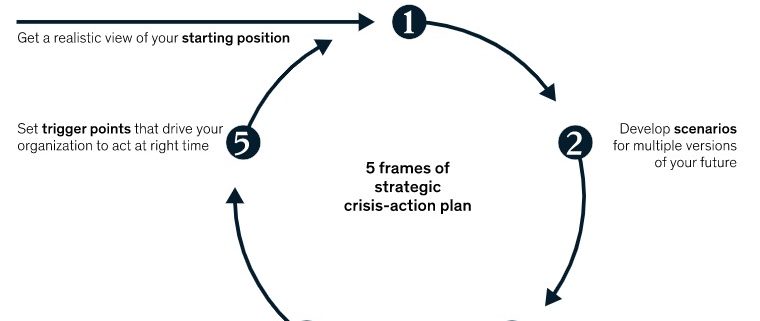
If there is a lot of uncertainty, you have to work at a high speed. Your bias should be towards speed and not perfection. And the sooner you start, the better you accept that your first response to a crisis will not be 100% correct, but you should get a better response after each iteration. Scenarios are refined and renewed, and more information is gained as time unfolds. Some things are lost; Others accelerate. Evolve your way to an answer in more complex situations.
When a series of problems from the next wave of the COVID19 crisis hits you, your planning team will be what will help you win the race against time. Start your planning team now to get through the next phase of the crisis.




No views